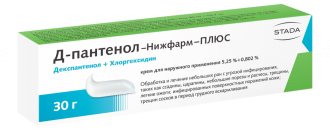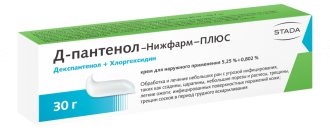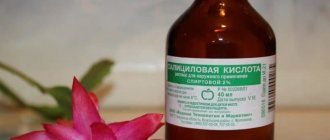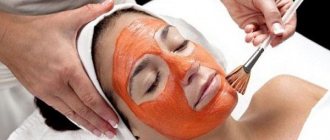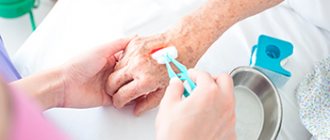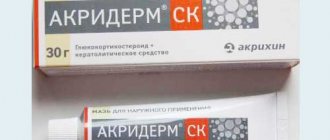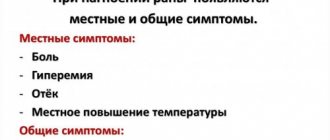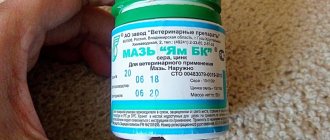Panthenol: composition
The active ingredient in panthenol cream, spray, ointment or balm is called dexpanthenol. The drug is available in different forms (cream, ointment, spray).
!
All these products are suitable for external use only.
Panthenol cream contains 5% active substance (50 mg per 1 g of cream). The remaining share comes from auxiliary components. The cream is produced in tubes of 25 and 50 grams. This is a homogeneous white product with a neutral aroma. Panthenol helps with cracked nipples in nursing women, stretch marks during pregnancy, scars, etc. It is also used for hemorrhoids (Haemorrois) as an aid.
Panthenol ointment also contains 5% of the active ingredient, but differs in the composition of the auxiliary components. It is a homogeneous yellowish substance with the aroma of lanolin. Panthenol ointment is used to treat very dry skin, trophic ulcers, bedsores, and wound surfaces. It is also produced in tubes of 25 and 50 grams.
Panthenol spray with a percentage of 4.63% of the active ingredient is most often used for sunburn. It is produced in aluminum cylinders of 58 and 130 grams.
Release form
- Tablets 100 mg No. 20 or No. 50.
- Solution for injection 250 mg/ml (ampoules 2 ml, package No. 10).
- Aerosol 5% 58 or 116 g (aluminum containers).
- Ointment 50 mg/g (tubes of 30 g).
- Skin foam (spray) 46.3 mg/g (pressure containers 130g, package No. 1).
- Gel 7% 75 ml.
- Lotion 10% 200 ml.
- Panthenol cream 5% (46 ml tubes).
- Gelatin capsules 40 mg.
- Body milk 3% 200 ml.
In addition, suppositories with Panthenol are produced for rectal and vaginal use and a nasal spray with dexpanthenol (the drug Moreal-plus ).
Dexpanthenol can be found not only in medicines, but also in cosmetics - in creams for face and body care, milk, serums, balms, shampoos, hair masks, caring and decorative varnishes.
Panthenol: properties for skin
If we talk about how panthenol works for the skin, then first of all we need to mention its regenerative effect. The product promotes rapid restoration of the epidermis. It also gradually reduces inflammation, stabilizes metabolism in cells, and strengthens collagen fibers. In addition, panthenol moisturizes the skin and is an excellent remedy for combating dryness.
For burns, injuries, wounds and various skin diseases, the product compensates for the deficiency of pantothenic acid from which it is produced. When used externally, it is well absorbed. The body converts the drug into pantothenic acid, and then binds it to plasma proteins.
!
The complex effect of panthenol on the skin has led to its demand in cosmetology and medicine.
Creams containing panthenol are used in the treatment of various skin diseases, varicose veins, cosmetic problems, etc. For example, Normaven® Foot Cream, which contains panthenol, has shown good results in the treatment of varicose veins and general improvement in the condition of the skin. This product was developed by highly qualified specialists from a pharmaceutical company, it was tested and was highly appreciated by doctors. The cream has all the necessary documentation and quality certificates and is approved for use by pregnant women. You can buy Normaven® Foot Cream in most pharmacies in the Russian Federation at an affordable price.
Panthenol - application and benefits
Interaction
When used locally according to indications, interaction with other drugs is unknown.
When applying the spray to the anal area or genitals in the case of using condoms, it reduces the strength of the latter when breaking. This is due to the fact that this dosage form of the drug contains mineral oil.
There is evidence that dexpanthenol, when taken orally and parenterally, prolongs the effects of succinylcholine .
The use of an injection solution in combination with general anesthesia, barbiturates and antibacterial drugs increases the risk of developing hypersensitivity reactions.
Panthenol: application
Panthenol ointment or cream is applied to the skin (for burns with boiling water, etc.) in a thin layer with previously washed hands. After application, the product must be rubbed in gently. The procedure must be repeated (on average 2–4 times a day, but more often). If panthenol cream, ointment or spray is used for purulent wounds, then an antiseptic treatment must be carried out before this.
The product is also recommended for infants for diaper rash and diaper dermatitis. It is applied to the skin every time after changing diapers and water procedures. Treatment continues until the skin is completely healed.
One of the most common ways to use panthenol moisturizing cream is to treat cracked and inflamed nipples in nursing women. The product is applied to the cracks every time after feeding, without washing it off. Reviews of ointment with panthenol confirm its ability to heal cracks.
Panthenol aerosol with a cooling effect is best suited for healing sun and other burns.
!
Burns are the main indication for the use of this remedy.
The instructions for the drug provide a precise description of how to apply panthenol spray to the skin. The sooner you use it after damage, the better the treatment effect will be. If you choose which is better - panthenol ointment or spray - to use for the treatment of burns, then you should give preference to the spray because of its convenient application.
To treat the surface of the burn, the can is held in a vertical position, shaken first, and then evenly applied to the skin. It is important to ensure that the entire burn is covered with foam. The spray foam is absorbed and has an analgesic and wound-healing effect. The product forms a thin film on the skin: it prevents moisture loss.
The spray must be applied after burns several times, taking into account the degree of damage.
Expert opinion
The most noticeable results are shown by products containing the original dexpanthenol, which cannot be said about cheaper analogues of this product.
Vascular surgeon, phlebologist
Osipova Ekaterina Yakovlevna
Panthenol price, where to buy
Cost of the drug in Ukraine
The average price of Panthenol ointment in Ukraine is 60 UAH (the cost of Panthenol-ratiopharm is 39-46 UAH, the drug from Hemofarm is about 87 UAH), you can buy Panthenol-cream in Kharkov or Kyiv for 32 UAH, tablets - for 200-220 UAH. Aerosol price - 30-35 UAH.
How much do spray, ointment and cream cost in Russia?
The cost of the cream is 85-200 rubles. (the price of 911 cream is 85 rubles, and the price of Panthenol Vialine cream is 180-190 rubles). The price of Panthenol spray is from 160 to 340 rubles. (depending on the manufacturer), aerosol - 315-320 rubles. Ointment for burns can be purchased for an average of 235 rubles.
- Online pharmacies in RussiaRussia
- Online pharmacies in UkraineUkraine
- Online pharmacies in KazakhstanKazakhstan
LuxPharma* special offer
- Panthenol tablet
100 mg 50 pcs 1590 rub. order
ZdravCity
- Wax Belweder (Belvedere) for nails and cuticles Panthenol forte 6 gBelweder France
RUB 229 order
- Moisturizing foot cream with silk proteins, panthenol and allantoin Marusya/Marussia 75ml LLC Nicole
55 rub. order
- Regenerating cream with panthenol and Aronyx peptides 50 ml MediFlowerCosmeticsCo., Ltd.
680 rub. order
- Serum with panthenol Aronyx 50 mlMediFlowerCosmeticsCo., Ltd.
RUB 812 order
- Moisturizing facial wash with d-panthenol Vitex Aloe 97% 200mlVitex JSC
99 RUR order
Pharmacy Dialogue
- D-panthenol-Nizhpharm ointment (tube 30g) Hemofarm LLC
280 rub. order
- D-Panthenol Novatenol ointment (tube 5% 25g) Jadran-Galenski
RUB 285 order
- D-Panthenol Novatenol ointment (tube 5% 50g) Jadran-Galenski
476 rub. order
- Tizin PANTHENOL (spray called dosage for children 0.05 mg + 5 mg/dose 10 ml (80 doses)) Famar Health Care Services Madrid S.A.U.
RUB 281 order
- D-Panthenol Novatenol cream (tube 5% 50g) Jadran-Galenski
RUB 467 order
show more
Pharmacy24
- Aqua Spray + D-Panthenol 45 ml spray PAT"Khimpharmzavod"Chervona Zirka",Kharkiv, Ukraine
69 UAH.order - Bepanten dexpanthenol 5% 100 g cream GP Grenzach Products GmbH, Nimechchina
355 UAH. order
- “Children’s” with D-panthenol 100 ml cream OOO NPL Fitoprodukt, Ukraine
15 UAH order
- Panthenol 58 g aerosol TOV "Mikrofarm", Kharkov, Ukraine
40 UAH order
- Balm after intense tanning with panthenol 150 ml TOV"VKF"Bioton", Ukraine
36 UAH order
PaniPharmacy
- Natura House Shampoo with D-panthenol for the sea and pool 250ml Italy, Natura House
162 UAH order
- Spray for safe tanning Biocon Sunscreen spray SPF50+ with panthenol Solar screen 160ml Ukraine, Biocon INPO LLC
79 UAH order
- Universal winter cream with panthenol 70ml Ukraine, Farmakom
48 UAH order
- PANTHENOL liquid Panthenol aerosol 130g Germany, Dr. Mann
151 UAH order
- Powder Panthenol 100g Ukraine, Farmakom PTF LLC
47 UAH order
show more
Panthenol: indications for use
Panthenol is a universal drug that is used to restore skin for injuries, burns, inflammatory diseases, varicose veins, etc. It helps to quickly heal the skin for all kinds of abrasions and cuts, dermatitis (Dermatitis), cracks, bedsores and trophic ulcers. For cosmetic purposes, the product can be used to protect against dry skin as a result of exposure to wind, frost, etc.
Indications for use panthenol
The ointment can be used on open wounds. It is also used to speed up healing during skin grafting. In addition, panthenol is widely used in cosmetics. Dry skin is treated with products containing it.
Contraindications
Intolerance to dexpanthenol or the auxiliary components contained in the drug.
Parenteral administration and taking tablets are contraindicated in cases of mechanical intestinal obstruction and hemophilia .
Additional contraindications for the tablets are childhood, glucose/galactose malabsorption syndrome , fructosemia , sucrose-isomaltase deficiency .
Local treatment of burn victims on an outpatient basis
Burns are one of the most common types of injuries. In Russia, more than 400 thousand patients with thermal burns are registered annually. Moreover, only 30% of them require hospitalization; the remaining patients are treated in the clinic. In addition, most patients with the consequences of thermal injury after discharge from the hospital also continue treatment and rehabilitation on an outpatient basis. Therefore, effective treatment of burn victims depends not only on the combustiologist working in the burn center. In many ways, qualified medical care for burns at the outpatient stage determines their further course, the possibility of developing complications and the outcome of the injury.
Local treatment of burns is carried out at all stages of evacuation and treatment of burned victims in accordance with the established volume of medical care for each stage.
First aid to burn victims should be provided immediately, already at the scene of the incident, and begin with stopping the action of the thermal agent and, if possible, removing all materials in contact with the burnt surface (clothing, jewelry, etc.). Further, for local burns up to 10% of the body surface, it is necessary to cool the damaged areas of the skin for at least 15-20 minutes with water or the use of cold objects. Immediate, no later than 30 minutes after injury, cooling the burned surface reduces the time of tissue overheating, preventing the action of the thermal agent on deeper tissues. Cooling reduces swelling and relieves pain, and has a great influence on the further healing of burn wounds, preventing deepening of the damage. The patient should also be given painkillers and antihistamines, in case of extensive burns, warmed up and, if there is no vomiting, given something to drink. During the period of transportation of victims to a medical facility in the presence of limited burns, the primary dressing may be a dry aseptic dressing; for extensive burns, standard contour dressings or sterile sheets are used for these purposes. The primary dressing should not contain fats and oils due to subsequent difficulties in cleaning wounds, as well as dyes, because they can make it difficult to recognize the depth of the lesion.
Ready-made first aid dressings can be used to bandage burnt victims. Among modern first aid dressings and subsequent treatment, especially for patients with limited burns of II-IIIAB degrees, modern wound coverings of the Activtex and APPOLO series, as well as aerosol preparations (Amprovisol, Olazol, Panthenol), can be used.
In clinics and outpatient clinics, medical care can be provided to patients with thermal injuries, including for urgent indications and in order to prepare the victim for transportation to a specialized or surgical hospital. In this case, treatment tactics are determined by the possibility of continuing it on an outpatient basis or the need for hospitalization in a hospital. The criteria for hospitalization of burnt victims are the extent and depth of burns, their localization, the presence of thermal inhalation injury, concomitant injury and concomitant diseases, as well as the age of the victim. It should be noted that during the initial examination it can be difficult to determine the depth of the burns. Most often, the true depth of the burn can only be determined after 5-7 days.
For an outpatient surgeon, it is necessary to have a clear understanding of the indications for hospitalization of burn victims:
Deep burns of IIIB-IV degree. Superficial burns of I-II degree - more than 15% of the body surface. Borderline burns of IIIA degree - more than 5% of the body surface. Burns of special localizations (face, hands, feet or genitals). Thermal inhalation damage. Burn shock .General electrical trauma. Combined or concomitant trauma. Wound infectious complications.
It is known that burn wounds are always infected. The development of inflammation in IIIAB-IV degree burns is a stage of the wound process and is caused not so much by the influence of microflora, which is always present in a burn wound, but by the natural processes of limitation and rejection of dead tissue. Therefore, the often used term “infected burn” is inappropriate. The concept of a wound infectious complication of burns includes conditions when the purulent process spreads beyond the primary lesion, leading to the development of both local (abscess, phlegmon, thrombophlebitis, etc.) and general (pneumonia, sepsis) infectious complications.
Indications for outpatient treatment of burnt patients
Adult patients with superficial I-II degree burns can be treated on an outpatient basis if the affected area does not exceed 10-15% of the body surface, and for borderline IIIA degree burns - 5% of the body surface, outpatient treatment of small-area deep pinpoint burns is also possible, for example from splashing hot oil. For this category of patients, the main thing is local conservative treatment of burn wounds.
Goals of local treatment of burns I-II-IIIA degrees
Local treatment for burns of I-II-IIIA degrees should be aimed at creating the most favorable conditions for their healing in the optimal time and provide protection of the wound from mechanical damage and infection, and, if necessary, effective treatment of wound infection and stimulation of reparative processes.
Primary toilet of a burn wound
Local treatment begins with the primary toilet of the burn wound. After anesthesia, carefully, in a minimally traumatic way, clean the burn surface from contamination, foreign bodies and scraps of epidermis. The wound is treated with antiseptic solutions. Opened bubbles are removed. Large unopened blisters are cut at the base and, without removing the epidermis, the contents are evacuated. Smaller bubbles do not need to be opened. In case of suppuration of the contents of the blisters, the exfoliated epidermis should be removed. It is better not to remove coagulated dry fibrin, since this will injure the underlying tissues; treatment in these cases is carried out under a thin scab. Tetanus prophylaxis is also recommended for all burn victims.
Local treatment of superficial and borderline burns
Treatment of burns of I-II-IIIA degrees can be carried out using both open and closed methods. Moreover, depending on the nature of the created wound environment, these methods are implemented using dry or wet methods. Treatment of burn wounds with the open method is possible on the face, in the genital area and perineum, where bandages make care and physiological functions difficult. In these cases, iodopirone solution, aerosols, and also creams containing silver preparations are used. However, in an outpatient setting, the method of choice is the closed method using various dressings.
For victims with local I-II degree burns, it is possible to use the aerosol drug Acerbin, which has an antiseptic and wound-healing effect. It can already be used when providing first aid. Acerbine, if necessary, is applied several times a day to the wound, which is covered with a sterile bandage soaked in the solution.
After removing the exfoliated epidermis in the absence of signs of infection, it is sufficient to use atraumatic dressings (Parapran, Voskopran, Branolind and others), a single application of which to superficial burn wounds is sufficient for subsequent epithelization under the bandage. You can use other wound dressings (Activtex, Appolo), as well as dressings with antiseptic or antibiotic solutions, water-soluble ointments or creams based on silver sulfadiazine.
For burns of IIIA degree, as well as small deep burns of IIIB degree, treatment can begin with wet-drying dressings with solutions of Iodopirone (Betadine, Povidone-iodine), which promote the formation of a thin scab consisting of necrotic layers of skin and fibrin. The disadvantages of the latter include pain during the first dressings. Under a dry scab, burns can heal without suppuration. In cases where a dry scab cannot be formed, already a week after the injury its suppuration and rejection develop. Treatment should be continued with bandages with water-soluble ointments, and the sloughed scab should be removed during dressings.
At the same time, the use of gauze dressings as a carrier for drugs has a number of disadvantages. Removing dried gauze dressings on dressings, even despite soaking, leads to traumatization of the young epithelium and disruption of spontaneous epithelization of the wound, and the dressings themselves are painful. That's why
The use of atraumatic “mesh” coverings in outpatient settings helps solve the problem of epithelial trauma, reduces the pain of dressings and has a beneficial effect on the course of the wound process.
One of the types of modern dressings is Activtex wound coverings, which are a textile base impregnated with a gel-forming polymer and containing various medicinal substances in the form of a depot system. Depending on the drugs included in the composition, various types of coatings with antibacterial, analgesic and hemostatic effects can be used. The therapeutic effect of the components that make up the Activetex coatings manifests itself only in a wet state, and therefore it is necessary to moisten the dressing before use and then periodically 1-2 times a day. The advantages of Activtex anti-burn dressings are the absence of the need for their preliminary (immediately before use) preparation and prolonged healing properties.
Dressings should be performed at least 2 times a week. If the patient's temperature rises, pain and swelling in the wound area intensify, the bandage becomes wet with pus, it should be replaced more often. Dressings should be performed sparingly, without injuring the thin layer of growing epithelium, especially in the treatment of IIIA degree burns, when epithelization occurs from preserved skin derivatives.
A modern alternative to the dry method of local treatment, when epithelization of superficial burns occurs under the scab, is to create a moist environment on the wound. A humid environment has a beneficial effect on regeneration processes, while the dressings themselves are atraumatic.
A wet dressing method for local treatment of burns is implemented using various film, hydrogel, hydrocolloid and sponge dressings, as well as creams based on silver sulfadiazine.
In the treatment of superficial and borderline burns, various film dressings are highly effective. At the same time, the lack of drainage properties of film dressings requires more frequent (daily) dressings, especially with heavy wound discharge. Therefore, the use of occlusive dressings is contraindicated in the treatment of purulent-necrotic and infected burn wounds with microbial contamination of more than 104 microbial bodies/cm2.
In the treatment of limited superficial and borderline burns, dressings containing hydrogels are widely used. Form-stable hydrogel coatings (Gelepran, Hydrosorb) show good effectiveness in the treatment of burn wounds of II-IIIAB degrees, as well as long-term wounds. Apollo's mesh-based dressing with an amorphous hydrogel differs favorably from its Western counterparts by the presence of anilocaine as an anesthetic and iodovidone as an antiseptic. Hydrocolloid dressings (Hydrocoll) can also be used effectively.
The use of biological materials in the treatment of superficial burns of the first and second degrees is inappropriate. When treating borderline IIIA degree burns in a clinic, various sponge coatings (Algimaf, Algikol, Syuspur-derm, etc.) can be used. They do not require frequent dressings, absorb wound detritus and promote regeneration.
The use of hydrogel, hydrocolloid and sponge dressings due to the active sorption of discharge allows dressings to be performed after 2-3 days, and in the absence of discharge and the dressings are tightly fixed to the wound, they can be left until complete epithelialization and independent separation from the healed surface.
Creams with silver, produced under various names (Argosulfan, Dermazin, Ebermin), which maintain a moist wound environment, create favorable conditions for epithelization and are effective means for local treatment of superficial and border burn wounds, especially in combination with film coatings.
The use of these drugs is advisable for clinical signs of infection and severe suppuration of burn wounds. In addition to them, it is possible to use a solution of Iodopirone (Betadine) and Lavasept. In the treatment of infected burn wounds, gauze dressings with multicomponent ointments on a water-soluble (polyethylene glycol) basis (Levomikol, Levosin, Dioxidin, Iodopyron, Betadine), which can be used in phases I and II of the wound process, have proven themselves well.
With an uncomplicated course of the wound process, the correct choice of methods and means of local treatment, II degree burns heal 1-2 weeks after injury, IIIA degree burns - by 18-21 days. Long-term conservative treatment of non-healing burn wounds in a clinic is a mistake. All burn wounds that have not healed within 3-4 weeks, especially those occupying an area of more than 0.5% of the body area, are deep and most likely require autodermoplasty.
Treatment of burnt patients discharged from the hospital with small residual wounds remaining after superficial burns and in areas of surviving grafts in those operated on for deep burns is carried out according to the general principles of local treatment indicated above.
The criteria for successful treatment of burnt patients is not only wound healing, but also good functional and cosmetic results. According to various studies, in 10% of cases after II degree burns, in 55-62% after IIIA degree burns and in 30-40% of cases after autodermoplasty for deep IIIB-IV degree burns, hypertrophic and keloid scars develop.
It should be noted that the main task in the fight against pathological scars is not so much their treatment as the prevention of scar formation. Carrying out anti-scar measures is most effective for “fresh” scars during the period of their formation. Most conservative treatment of burn scars occurs on an outpatient basis. Typically, a comprehensive course of treatment is carried out over 6-12 months, combining various methods: general and local drug treatment, wearing compression clothing, physiotherapy, massage, physical therapy, balneological treatment, etc.
When carrying out rehabilitation of burn survivors, it is important to take into account that many patients have mental disorders associated with the consciousness of their inferiority. This circumstance requires a special approach and often the need for drug correction. In addition to the development of scars and deformities, patients who have suffered a severe burn disease may have various dysfunctions of internal organs, requiring the involvement of appropriate specialists in the examination and treatment of such victims. Our country does not yet have a unified system for the rehabilitation of burn victims. Training clinic surgeons in the specifics of treatment and rehabilitation of burn victims with the involvement of specialists from burn departments may be one of the ways to solve this problem. More attention should also be paid to improving the system of medical and labor examination of burn survivors and their employment.
After 6-12 months of outpatient conservative treatment after the scars have “matured,” the patient, if necessary, undergoes reconstructive surgery. In cases of rapid progression of microstomia and eyelid eversion, the patient is advised to undergo reconstructive surgery urgently.
The emergence and introduction into clinical practice of new drugs and wound dressings makes it possible to improve the quality of medical care for patients with thermal injuries, including in a clinic, subject to compliance with the appropriate protocols and standards of treatment.

